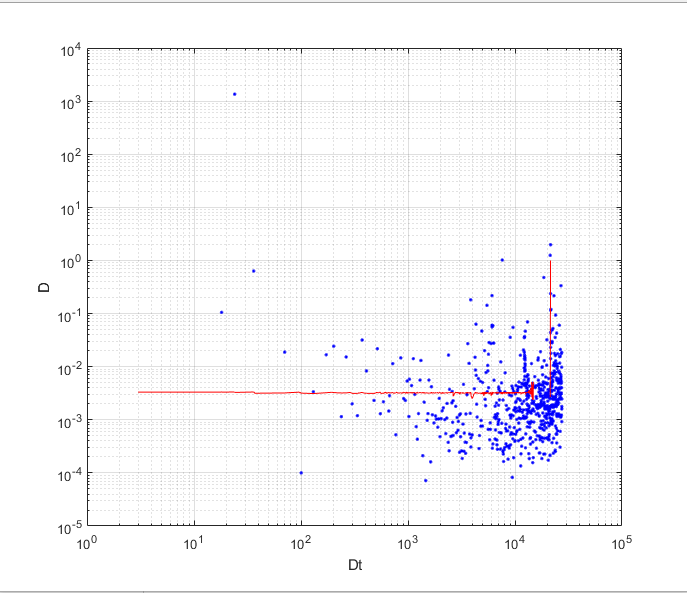@wikipedia
A specific type of mathematical model of Decline Curve Analysis, based on the following equation:
| LaTeX Math Block |
|---|
|
q(t)=q_0 \cdot \left( 1+b \cdot D \cdot t \right)^{-1/b} |
where
| Initial production rate of a well (or groups of wells) |
| LaTeX Math Inline |
|---|
| body | D=-\frac{1}{q}\frac{dq}{dt} |
|---|
|
| decline decrement (the higher the the stronger is decline) |
| defines the type of decline (see below) |
The cumulative production is then given by:
| LaTeX Math Block |
|---|
|
Q(t)=\int_0^t q(t) \, dt |
and the ultimate recovery is defined as:
| LaTeX Math Block |
|---|
|
Q_{\rm max}=Q(t=\infty)=\int_0^\infty q(t) \, dt =\frac{q_0}{D \cdot (1-b)} |
Arp's model splits into three types based on the value of
coefficient:
| Exponential | Hyperbolic | Harmonic |
|---|
| | |
| LaTeX Math Block |
|---|
| q(t)=q_0 \exp \left( -D \, t \right) |
|
| LaTeX Math Block |
|---|
| q(t)=q_0 \cdot \left( 1+b \cdot D \cdot t \right)^{-1/b} |
|
| LaTeX Math Block |
|---|
| q(t)=\frac{q_0}{1+D \, t} |
|
| LaTeX Math Block |
|---|
| Q(t)=\frac{q_0-q(t)}{D} |
|
| LaTeX Math Block |
|---|
| Q(t)=\frac{q_0}{D \, (1-b)} \, \left[ 1- \left( \frac{q(t)}{q_0} \right)^{1-b} \right]
|
|
| LaTeX Math Block |
|---|
| Q(t)=\frac{q_0}{D} \, \ln \left[ \frac{q_0}{q(t)} \right] |
|
| LaTeX Math Block |
|---|
| Q_{\rm max}=\frac{q_0}{D} |
|
| LaTeX Math Block |
|---|
| Q_{\rm max}=\frac{q_0}{D \cdot (1-b)} |
|
| LaTeX Math Block |
|---|
| Q_{\rm max}=\infty |
|
The Exponential and Hyperbolic decline are applicable for Boundary Dominated Flow with finite reserves
| LaTeX Math Inline |
|---|
| body | --uriencoded--Q_%7B\rm max%7D \leq \infty |
|---|
|
while
Harmonic decline is associated with production from the reservoir with infinite reserves
| LaTeX Math Inline |
|---|
| body | --uriencoded--Q_%7B\rm max%7D = \infty |
|---|
|
. In other words the
Harmonic decline is very slow.
Since all physical reserves are finite the true meaning of Harmonic decline is that up to date it did not reach the boundary of these reserves and at certain point in future it will transform intoa finite-reseves decline (possibly Exponential or Hyperbolic).
Exponential decline has a physical meaning of declining production from finite drainage volume
with constant
BHP:
| LaTeX Math Inline |
|---|
| body | p_{wf}(t) = \rm const |
|---|
|
(a specific type of
Boundary Dominated Flow under
Pseudo Steady State (PSS) conditions).
Harmonic and Hyperbolic declines are both empirical.
The DCA Arps do not cover all types of production decline, but their application is quite broad and mathematics is quite simple which gained popularity.
See Also
Petroleum Industry / Upstream / Production / Subsurface Production / Field Study & Modelling / Production Analysis / Decline Curve Analysis
References
Arps, J. J. (1945, December 1). Analysis of Decline Curves. Society of Petroleum Engineers. doi:10.2118/945228-G
| Show If |
|---|
|
| Panel |
|---|
|
| Expand |
|---|
| Просматривать график лучше используя коэф-т потерь Арпса: 
|
|
|
